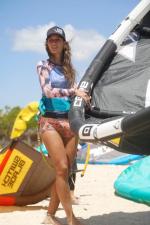
Entering the European market for water sports tourism
The water sports tourism market is shaped by intangible requirements, such as wind, waves, climate and the underwater environment. But each niche within this market also has a wide range of tangible requirements. For instance, putting in place a sustainable code of practice is key to attracting European buyers. Relevant sales channels for this market include specialist tour operators, online travel agents (OTAs) and direct sales. The water sports segment is very competitive, as many types of water sports can be practised in destinations all over the world.
Contents of this page
1. What are the European requirements for water sports tourism?
European water sports tour operators must comply with several regulations to ensure that their clients are safe and financially protected. Individual companies will also have their own requirements when working with operators, including sustainability rules. These are usually set out in their code of conduct and/or terms of business. It is critical to understand these requirements and update business processes where necessary to meet companies’ expectations. Sustainability in all areas of tourism provision is essential for European tourism suppliers, so you must embed sustainability in your business.
What are the mandatory and additional requirements that buyers have?
There are mandatory and additional requirements for water sports tourism across the sector. They include:
- The European Package Travel Directive
- The General Data Protection Regulation (GDPR)
- Liability insurance and insolvency protection
To find out more about these requirements, read the CBI study What are the requirements for tourism services in the European market?. This study will help you understand the legal, non-legal and common requirements that European tour operators must comply with. If you understand these requirements and can adapt your business accordingly, tour operators will be more likely to do business with you. It is important to European buyers that they can trust their suppliers to meet their and their customers’ needs.
What are the requirements for niche markets?
Water sports are very popular activities for European travellers when they are on holiday. Some of the most important requirements for water sports are outside the control of the tour operator (intangible requirements). These requirements depend on the environment and can include the clarity and cleanliness of the water, the consistency of the waves, the reliability of wind and the quality of the underwater environment. Other requirements are tangible, pertaining to things like equipment, instructors and so on.
It is therefore important that you do your research to understand the best conditions for the sports you offer. For instance, although kitesurfing and windsurfing are similar sports, they may require slightly different conditions, and you should know what they are.
Depending on the type of tourism business you operate, be aware of the following ground rules:
- A kitesurfing or windsurfing business requires a school with suitable equipment, courses for people with different skill levels, and expert instructors.
- The same applies to surf schools that offer stand-up surfing lessons.
- Extreme sports instructors should have proper, internationally recognised qualifications. You should know what these are.
- Beaches in areas offering board sports should be monitored by lifeguards, and sections of beach should be roped off to protect others.
- Businesses offering kayaking and/or canoeing trips must have a fleet of well-maintained vessels, as well as lifejackets, helmets and experienced guides.
- Businesses offering casual recreational boating experiences must ensure that their boats, aqua trikes, pedal boats and other equipment are seaworthy and well maintained.
- Businesses offering adrenaline sports like parasailing and other towed water sports usually rely on powerboats or motorboats. Equipment and boats must always be maintained to the highest standard to ensure participants’ safety.
- Motorised boats, inflatables and other personal watercraft (jet skis, etc.) should also be maintained under formal maintenance and safety programmes.
Figure 1: Whitewater rafting is popular on fast-moving rivers around the world
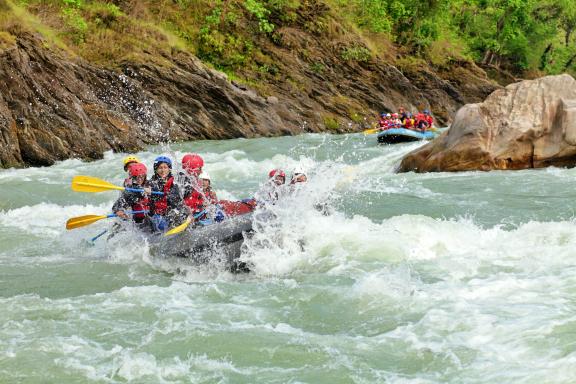
Source: Chandan Chaurasia at Unsplash
Establish sustainability through a code of best practice
All water sports tourism businesses should strive to establish sustainability standards through a code of best practice. The Adventure Travel Trade Association (ATTA) and Travelife have developed a set of sustainability guidelines for tour operators. There are different guidelines for different types of business. They offer practical and useful advice covering a wide range of sustainability actions, as well as other practical applications.
In the water sports niche, there are standards for caving, fishing, non-motorised boating, surfing and SUP, personal watercraft, motorised boating, shark cage diving and snorkelling. See an example of the standards for surfing and SUP below.
Figure 2: Sustainability Codes of Best Practice
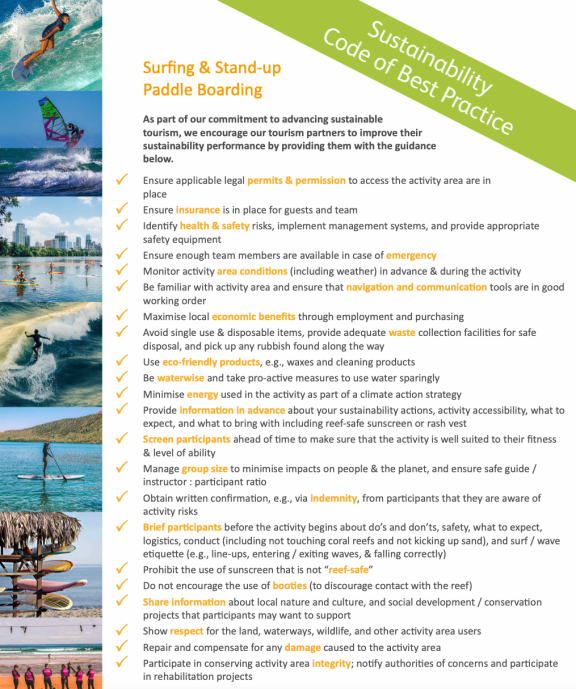
Source: ATTA
Download the Sustainability Codes of Best Practice and see which parts you can adapt for your business.
You should consider becoming a sustainably certified tourism business. Although this is not yet mandatory, more and more tourism buyers are demanding sustainability guarantees. Europeans want to know that their holidays are not harming people, places or the planet. Making a positive contribution to local communities is also very important to them. Implementing a sustainable code of practice, as described above, is the first step. Becoming certified is the next step.
Travelife for Tour Operators is the best-known sustainability certification scheme in Europe. The Good Seal Scheme is an affordable scheme for SMEs. Do some research to see if you can become certified.
For more information about sustainability, read the CBI study How to be a sustainable tourism business. It outlines all the major sustainability certification schemes on the market.
Comply with international standards
You should consider whether applying for certification would help your business. Although certification is not mandatory, complying with an internationally recognised standard can help you build your reputation as a trustworthy supplier. The table below shows the main standards for individual water sports.
Table 1: ISO standards for water sports
| Sport | Details of standard |
| Water sports | There are seven ISO standards that cover safety requirements for the design, use, stability and load capacity of ‘floating leisure articles for use on and in the water’, such as stand-up paddleboards and canoes. You can check out each of these ISO 25649 standards and consider whether or not compliance with one or more of them would benefit your business.
The ISO 25649-7:2017 covers safety requirements and testing for small floating crafts like kayaks and canoes, and inflatable boats that are used for leisure purposes.
|
Adrenaline water sports (parasailing, whitewater rafting, etc.) | Two international standards are widely used in the adventure tourism segment. The ISO 21101:2014 covers safety management systems. The practical guide for SMEs can help you develop, implement and continually improve a safety management system. The British BS8848:2014 standard sets out requirements for adventurous activities outside of the United Kingdom. |
Source: Acorn Tourism Consulting
It can be expensive to become accredited by the ISO. You will first have to buy the guidelines and take measures in order to meet the requirements. You will then pay for an independent auditor to assess your business and award your certificate. However, your buyers will be impressed if you have ISO accreditation.
Tip:
- Comply with sustainability criteria and ISO standards even if you cannot afford to be sustainably certified or ISO accredited at this stage. You can tell your buyers about this in your marketing materials so they know that you are doing everything you can to operate sustainably, and that you are aiming to raise your standards.
2. Through what channels can you access the European market?
Hard and soft adventure tourists take part in lots of water sports, at varying levels of difficulty. They buy their water sports products from a variety of sources, including European tour operators, OTAs and directly from local tour operators. OTAs are good platforms for recreational water sports, but it is important not to rely on them for all your sales.
How is the end-market segmented?
European travellers who take part in water sports activities while on holiday come from all consumer groups and age groups. Broadly, they are hard or soft adventure travellers. Traditional holidaymakers and fully independent travellers (FITs) are two other important categories in the water sports market that may overlap with hard and soft adventure tourists.
- Hard adventure tourists often travel to a destination for the specific purpose of practising their chosen water sport, such as windsurfing, kitesurfing or surfing. Hard adventure water sports tourists are similar to tourists who do extreme sports.
- Soft adventure tourists are a very large group of travellers who take part in water sports activities while on holiday, such as stand-up paddleboarding (SUP), waterskiing and body surfing. They may also try hard adventure water sports activities, with or without instruction.
- Traditional holidaymakers include people of various ages, genders and socio-economic backgrounds. They will take part in general water sports activities that are available to them, and that usually involve minimal skill. These include swimming, snorkelling, recreational boating activities and SUP. Families are a substantial market in this group.
- FITs like to plan their own trips and make their own decisions about the activities they do. Water sports activities are likely to be included as part of a wider trip. This group is also more likely to try new things, like taking diving or sailing lessons, trying kitesurfing or whitewater kayaking. As a result, they are a mix of hard and soft adventurers. You can find out more about the FIT market in the CBI study What are the opportunities in the European FIT tourism market?.
Tip:
- To find out more about the market, and about the profiles of European water sports enthusiasts, read the CBI study The European market potential for water sports tourism.
Through what channels do water sports tourism products reach the end-market?
The main sales channels for water sports products are a mix of tour operators that specialise in specific water sports, general/adventure tour operators and OTAs. Direct sales also account for a proportion of sales, particularly for recreational and leisure water sports activities. The chart below gives a broad outline of the sales channels in the water sports segment.
Figure 3: Sales channels in the water sports segment
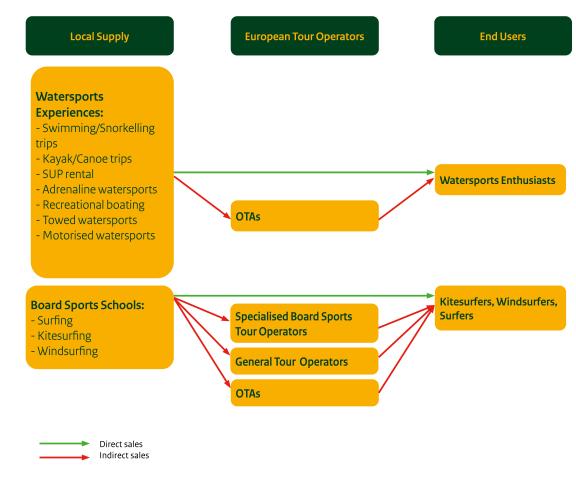
Source: Acorn Tourism Consulting
More details about each sales channel are provided below.
Specialist tour operators: these tour operators focus only on the water sport they offer. They are usually used by people who are passionate about the sport in question, and by others who are keen to improve their skills or practise their sport in a ‘must visit’ destination. They are especially common in the board sports, diving, sailing and fishing niches. Examples include Planet Kitesurf Holidays (UK), Kitereisen and Pure Surf Camps (Germany), and Gota Dagua (Sweden).
General tour operators: these tour operators offer a wide range of holidays with many themes and activities. These may include water sports. Examples include:
Online tour operators (OTAs): recreational water sports and adrenaline water sports are very common on OTA platforms. There are many SMEs that use OTAs – like Viator, Tripadvisor, GetYourGuide and Tourradar – to promote water sports experiences all over the world.
Direct sales: these are sales you make directly by phone, in person, or through your website or social media channels. It is very important to have a good website for direct bookings, ideally one that can process payments.
Finding buyers and networking in the water sports segment
Specialist water sports associations may help you find buyers and network with relevant organisations. Do your research to see if you can find membership lists and/or tourism businesses linked to the association. Use the lists below to help you.
Wild swimming
Kayaking/canoeing
Kitesurfing, windsurfing and surfing
- International Kitesurfing Association
- International Windsurfing Association
- International Surfing Association
Rafting
What is the most interesting channel for you?
If you offer recreational water sports, OTAs are the best sales channel for you to list your tours. Water sports experiences are very common on OTA platforms. Do a search on Viator or Tripadvisor for water sports experiences in your destination to see what the market looks like.
Figure 4: Kayaking tours in India on Tripadvisor
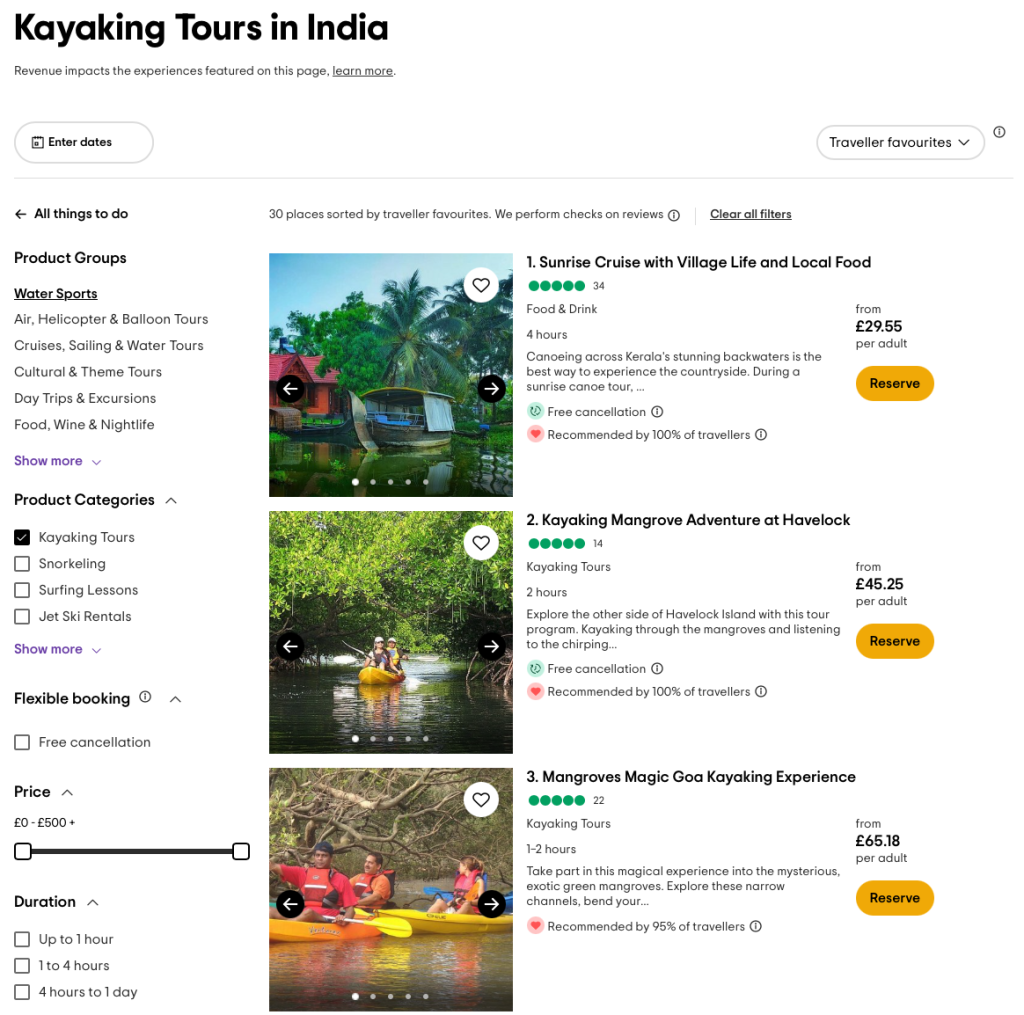
Source: Tripadvisor
However, you should not rely on OTAs for all your sales. OTAs are fast-moving, dynamic marketplaces, and if you become too dependent on them you may be in trouble if something goes wrong, or if the costs of using them become too high. Selling directly to European water sports enthusiasts will help you maximise your profits and broaden your appeal.
You can also approach specialist tour operators and introduce them to your school/business. As specialist operators, they will be interested in ideas to attract new customers. To ensure that you are successful, do your research before reaching out.
Tip:
- For more information on working with OTAs, building or improving your own website, and doing business with the European market, consult the CBI studies How to work effectively with OTAs?, Tutorial on how to be a successful tourism company online and 10 tips for doing business with European tourism buyers.
3. What competition will you face in the water sports tourism market?
The water sports segment is very competitive. Water sports can be done wherever there is a body of water, whether it is an ocean, sea, river, lake or pond. Developing countries have some of the best conditions for water sports. The climate in these destinations is often more favourable compared to many European countries. The chart below shows some of the world’s best places to participate in water sports.
Table 2: Competing destinations by water sport niche
| Wild swimming | Kayaking/canoeing | Kitesurfing, windsurfing, surfing | Rafting |
China Colombia Costa Rica Japan Iceland Jordan Mexico Oman Philippines South Africa Turkey Zambia | Argentina Belize Botswana Chile Galápagos India Mexico Namibia Turkey Vietnam Zambia | Bali Brazil Cape Verde Costa Rica Dominican Republic Mexico Morocco Nicaragua Peru South Africa Sri Lanka Thailand Vietnam | Bali Chile Costa Rica Ecuador Nepal Zambia Zimbabwe
|
Source: Acorn Tourism Consulting
You should consider all the countries listed in the table above as competing destinations when you do your research.
Which countries are you competing with?
This report profiles India, Mexico, Morocco, Indonesia, the Dominican Republic and South Africa as major competing destinations.
India
India is one of the world’s top adventure destinations, and visitors can enjoy a wide range of water sports throughout the country. Its diverse landscape ensures plenty of variety.
The Goa region on India’s west coast is a hotspot for all sorts of water sports, including board sports, diving and sailing. Water sports enthusiasts can also try water zorbing, where participants run across the water in a giant inflatable ball. Other regions that offer good water sports include Kavaratti in Lakshadweep (kayaking, diving, snorkelling), Kovalam in Kerala (boating, kayaking, parasailing, board sports, water skiing), Rishikesh in Uttarakhand (rafting, surfing, cliff jumping), the Andaman Islands (diving, snorkelling), Pondicherry (diving) and Zanskar in Jammu and Kashmir (rafting, kayaking).
Figure 5: Water sports in Goa
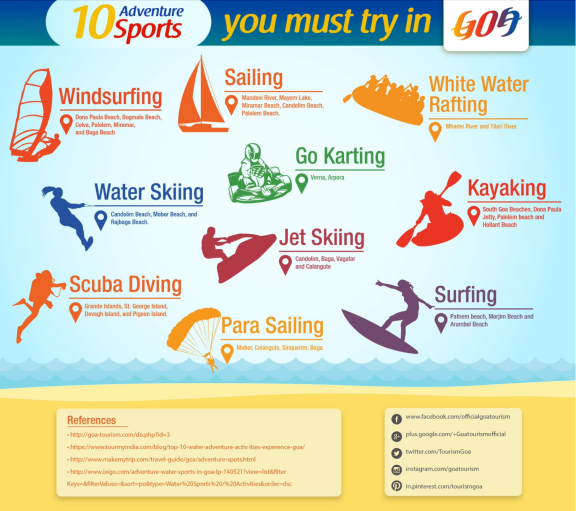
Source: Goa Tourism
Mexico
With more than 10,000 kilometres of coastline on both the Atlantic and Pacific, Mexico is an excellent destination for water sports. There are opportunities for many adventurous water sports like windsurfing, surfing and kitesurfing, diving, sailing and fishing. The recreational market is also well catered for, with boating trips, swimming with dolphins and towed water sports.
Mexico is also home to spectacular cenotes (natural fresh water ponds) and underwater caves, which are often connected by underground rivers and feature unique geological formations. They are mostly concentrated in the Yucatan Peninsula region, with the cenotes of Tulum, Cancún and Mérida reported to be the best.
Water sports can be done in lots of places around Mexico. Top destinations for diving include Puerto Vallarta, the island of Cozumel and the Baja peninsula. Kayaking is very popular in La Paz, Cabo San Lucas, Acapulco and Cancún, while whitewater rafting is done on the Rio Antigua and Rio Pescados in the state of Veracruz. The best surfing beaches are found on Mexico’s Pacific coastline, where experienced surfers travel long distances to find the best waves and uncrowded beaches.
Morocco
Morocco’s Atlantic and Mediterranean coastlines are excellent destinations for all types of water sports. Morocco is also easily accessible from Europe – there are many airlines serving the country, and the time difference is just one hour for continental western Europe. For visitors from the UK, there is no time difference.
The Atlantic coastal towns of Dakhla, Safi, Essaouira and Taghazout are ideal for board sports, as the wind and waves make for great surfing. This stretch of coastline is highly sought after by enthusiasts from all over the world. The calmer waters of the Mediterranean are more suited to jet skiing and other recreational boating activities. It is also possible to dive and fish in the Mediterranean region.
Figure 6: Windsurfing and other board sports are popular on windy coast
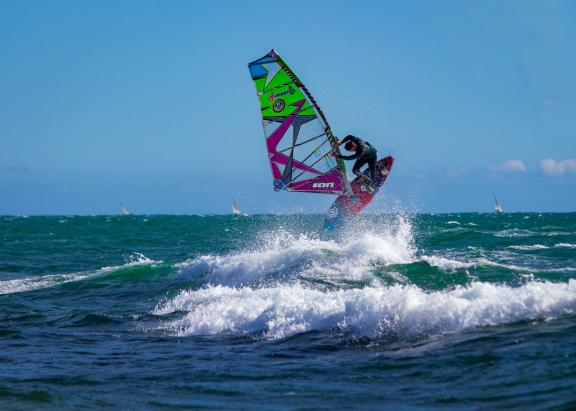
Source: Renan Brun on Unsplash
Indonesia
Indonesia’s many thousands of islands make it an ideal destination for water sports. As the archipelago’s top destination, the island of Bali offers many water sports, including surfing, tubing and whitewater rafting. Motorised water sports such as flyboarding, waterskiing and parasailing are also commonly practised. Meanwhile, some of the best surf spots for both beginners and professional surfers are found on the Mentawai Islands, South Lombok and Sumba.
South Africa
Water sports are a key feature of South Africa’s outdoor adventure culture. The country’s warm climate means that water sports can be enjoyed year-round. The major coastal cities of Cape Town, Port Elizabeth and Durban are all important hubs for water sports activities.
Surfing is very popular in South Africa because of the widespread availability of ocean waves, but there are many other water sports to be enjoyed. These include shark cage diving, seal snorkelling, kayaking, kitesurfing and SUP.
Waterskiing, wakeboarding, windsurfing and jet skiing are popular activities at large dams around the country, such as the Bronkhorstspruit Dam, Vaal Dam and the Albert Falls Nature Reserve.
Dominican Republic
The Dominican Republic is one of the best places in the world for kitesurfing and windsurfing. The town of Cabarete is world famous and hosts major professional competitions. Punta Cana in the south is another popular destination for water sports.
There are many schools in the Dominican Republic that provide excellent water sports courses, and the country has taken full advantage of its ideal wind and wave conditions. Other water sports that can be enjoyed in the Dominican Republic include surfing, kayaking, canyoning and rafting, making it a great adventure destination.
Key takeway:
Research the most popular locations for water sports in your destination, and find out why they are beloved (beach, coastline, wind, waves, geological features and so). Identify whether your [A1] product could fill a gap in the market, or whether you could create a new product to complement those already available.
Which companies are you competing with?
Water sports businesses are very common in competing destinations. Many can be found on or close to beaches and coastlines all over the world. This section offers short profiles of businesses in the water sports segment in relevant locations.
India
Goa Water Sports is a leading water sports provider in India, based in the coastal state of Goa. The company offers a wide range of programmes, including jet skiing, rafting and various boat cruises to suit all preferences. Particularly popular are its flyboarding tours, which take place on the gentle Chapora River and are offered year-round. The programmes are short and budget friendly, and pictures can be added for an additional cost. The website has a clear layout with a good use of infographics to convey simple messages, like the one below.
Figure 7: Why book with Goa Water Sports?
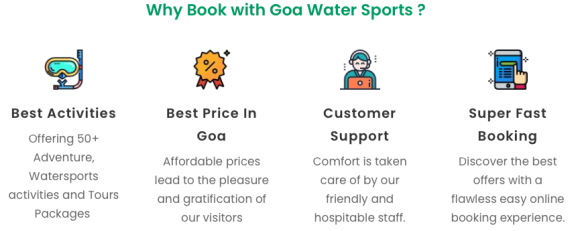
Source: Goa Water Sports
Syzygy Ecosports specialises in kayaking tours along the coastline of Kerala. The goal of the company, which was started in 2013, is to provide low-impact recreational activities that contribute to the local economy while conserving Kerala’s natural environment. Tours take place on Paravur Lake and either focus on the natural sandflat islands and sandbars to the south, or on the gorgeous natural mangrove forest to the north. The homepage features a great slogan: ‘Make you feel alive again’.
Mexico
Cenote tours are popular in Mexico. Ocean Tours Mexico offers lots of water sport tours, like the cenote discovery tour, as well as snorkelling excursions and whale shark tours. Based in the Riviera Maya region, the operator aims to provide tours rich in nature, culture and adventure. Its website reassures customers by stating that refunds are offered up to 24 hours before the tour, and the homepage features good promotions. It also makes good use of ‘call to action’ buttons, like ‘Book Now’ and ‘Contact Us’.
Okala Surf School offers personalised surfing lessons (tailored to the student’s age and experience) around Banderas Bay and Puerto Vallarta. Children are welcome, and for those who are more confident about their surfing abilities an advanced programme is available with a specialised local guide. Paddleboarding and snorkelling tours are also on offer. The website is bright and colourful, with lots of large, inspirational images and plenty of great testimonials. The business is run by three brothers who grew up in the area.
Morocco
Located in Agadir, in the south of Morocco, Ecolodge Adventures offers a huge range of programmes, including multiple water sports options. Jet skiing, boat trips and paddleboarding are all popular, as well as the Paradise Valley Trip, which includes hiking and swimming in the area’s many natural streams and pools. All transportation is included, as well as a local guide who speaks English, French and Arabic.
Marrakech Surf & Snow provides many water sports activities on Morocco’s coast as well as inland. Surfing excursions can be taken to Essaouira, or overnight to Taghazout, Sidi Kaouki or Imesouane. These are mostly full- or multi-day trips, but plenty of shorter activities are also available. The operator’s cable wakeboarding programmes – which take place in a specialised water resort offering great views of the picturesque Atlas Mountain range – are very popular.
Marrakech Surf & Snow’s website is a bit dated compared to other operators in this market, but there are plenty of appealing images with inspirational copy. The clear ‘Book Now’ button opens the user’s email.
Indonesia
With Bali being the premier destination for water sports in Indonesia, Smart Bali Tours offers a wide range of activities, including parasailing, rafting and sea walking. Packages are also available for tourists looking to experience all of these activities. The company has many reviews on Tripadvisor and its activities are short and affordable, often taking only an hour or two, with transport fully included. The tour descriptions are well written, but the operator could add more information to its website, such as an ‘About Us’ page and an explanation of how it contributes to sustainability.
South Africa
Stoked Surf is based in Cape Town and caters for both beginners and professional surfers. It has surfing instructors and mobile guides who use a van to ensure that surfers get to the right beaches for the best conditions on any particular day. The company also offers guided SUP experiences that offer spectacular views of Cape Town from the water. Other multi-day trips combine surfing with Cape Town highlights, like the winelands or wildlife watching.
The operator’s website has lots of appealing inspirational images of the ocean, sandy beaches and surfers. The website also has a blog, Surfing in Cape Town, which helps potential customers find it by improving its search engine optimisation (SEO).
Dominican Republic
Cabarete Tours is an online tour operator based in Cabarete, on the Dominican Republic’s north coast. It offers a range of local tours, including kayaking, waterfall tours, canyoning and river rafting. As an online operator, it claims its tours are more competitively priced than those offered by rival businesses. All the guides are locally based and have lived in the country for many years. Its website is simple, but all relevant information is available, such as what the tour includes and what customers should bring. This is important for European buyers. There are also lots of images to attract potential buyers.
Key takeaways:
- Take a critical look at your website. Do you have lots of great ‘action’ images and videos that show what potential guests could enjoy? Is it easy for customers to make a booking or to contact you? Make sure that you have clear calls to action, like ‘Book Now’ buttons.
- Make sure you promote any certifications and memberships of tourism organisations. This will impress your customers and reassure them that you are a professional company.
- Make sure you have lots of additional information on your website. An ‘About Us’ page, terms and conditions, and your eco-credentials are all important ways of adding value and appeal for European buyers.
- If you use lots of images on your website, make sure you size them appropriately. If they are too high resolution, they will take a long time to load, which makes for a frustrating experience for users. Ask your web developer for advice or do your own research. This blog offers some useful information: Best image size for websites in 2023.
Which products are you competing with?
Because of the large number of water sports, the main competition in this segment comes from competing businesses. But you are also competing with other adventure tourism niches, particularly in the soft adventure arena. It is unlikely that a kitesurfer would choose to go hiking or cycling instead, but casual adventurers are likely to try a few different activities while on holiday.
Participants in skilled water sports, like kitesurfing, are making a conscious decision to engage in that sport. If you have a business that caters for one of these sports, other specialised operators are your main competition, and you should measure your business against them.
Taking part in recreational water sports, like boating, snorkelling, kayaking and motorised water sports, may be spontaneous. This means that you are competing with all sorts of different businesses to attract large markets of people who want to have exciting and fun experiences in or on the water.
Tip:
- Do research on all businesses in your region that offer similar products to yours. See how your business measures up and compare your offers. Identify where you could offer something a bit different, or add value, so you stand out.
4. What are the prices of water sports tourism products?
Prices for water sports experiences vary widely, and there are no standards. Learning a new water sport like surfing, windsurfing, kitesurfing or diving requires time and expertise, and is more expensive than hiring a SUP for an hour or so. Similarly, shark cage diving requires a lot of time, resources, safety protocols and qualified boat operators, and is therefore more expensive than renting a jet ski for a short period of time.
Table 3: Prices for water sports experiences per person (pp) in competing countries
| Experience | Country | Duration | Price per person (€) |
| Mangrove Forest Kayaking Trip | India | 4 hours | 11 |
| River Rafting in Goa | India | 2 hours | 22 |
| Glass-Bottom Boat Tour & Coral Reef Viewing | Jordan | 3 hours | 28 |
| Canyoning in the Ciguapa Falls | Dominican Republic | 1 day | 34 |
| Parasailing Adventure Bali | Indonesia | 30 minutes | 37 |
| Flyboarding in Goa | India | 45 minutes | 39 |
| Paradise Valley Trip from Taghazout | Morocco | 4.5 hours | 40 |
| Whitewater Rafting on the Yaque del Norte River | Dominican Republic | 1 day | 50 |
| Agadir Jetski Experience | Morocco | 1 hour | 50 |
| Seawalking in Bali | Indonesia | 1.5 hours | 51 |
| Snorkelling Los Arcos de Mismaloya Tour | Mexico | 4 hours | 84 |
| Advanced Surf Adventure | Mexico | 4 hours | 93 |
| Cable Wakeboarding | Morocco | 1.5 hours | 95 |
| Great White Shark Cave Diving | South Africa | 6 hours | 136 |
Source: Acorn Tourism Consulting
Tips:
- To set your own prices, find out what other businesses in your area are charging, as they are likely to have a comparable offer. Be sure to compare your products to similar products when you do your research. If other businesses are charging more, they are probably offering added value, like complimentary snorkels and fins, or lunch.
- For more information on setting prices, consult the CBI study 10 tips for doing business with European tourism buyers and see tip 7, Set a fair price for your services.
Acorn Tourism Consulting Limited carried out this study on behalf of CBI.
Please review our market information disclaimer.
Search
Enter search terms to find market research
